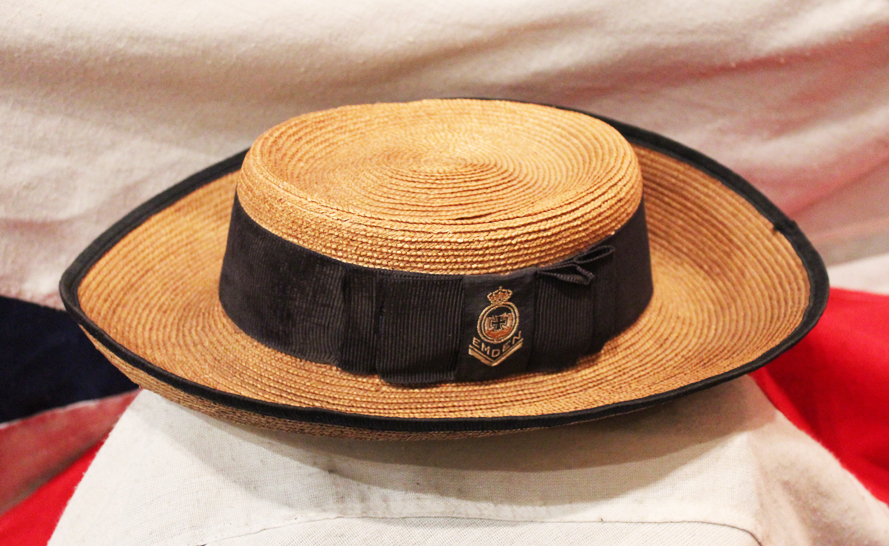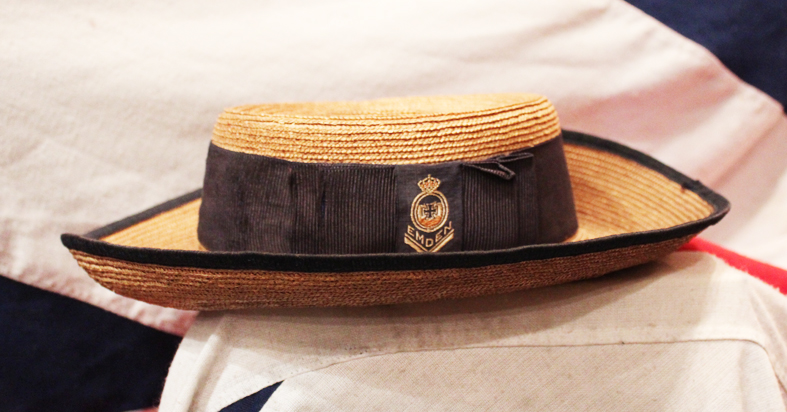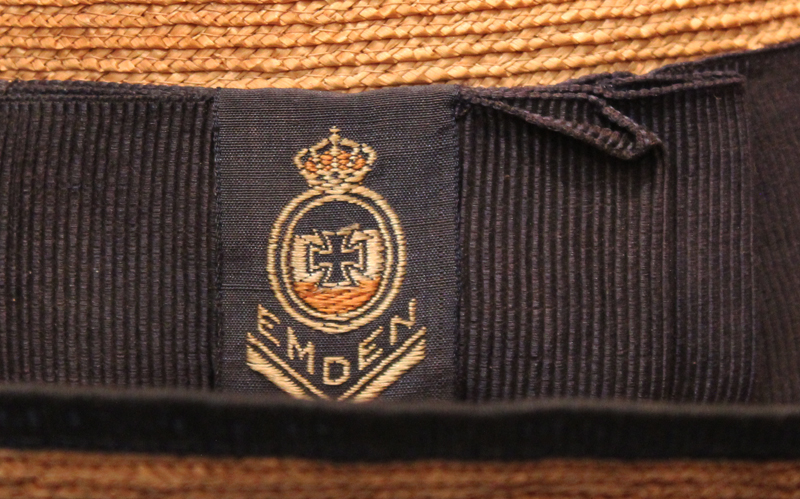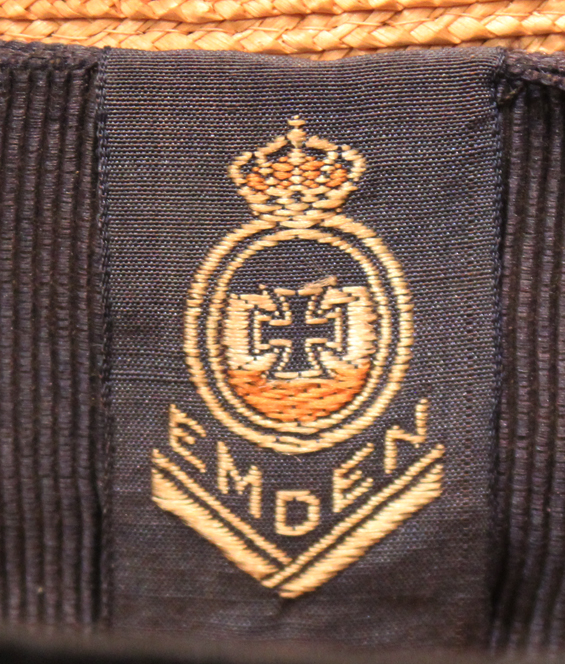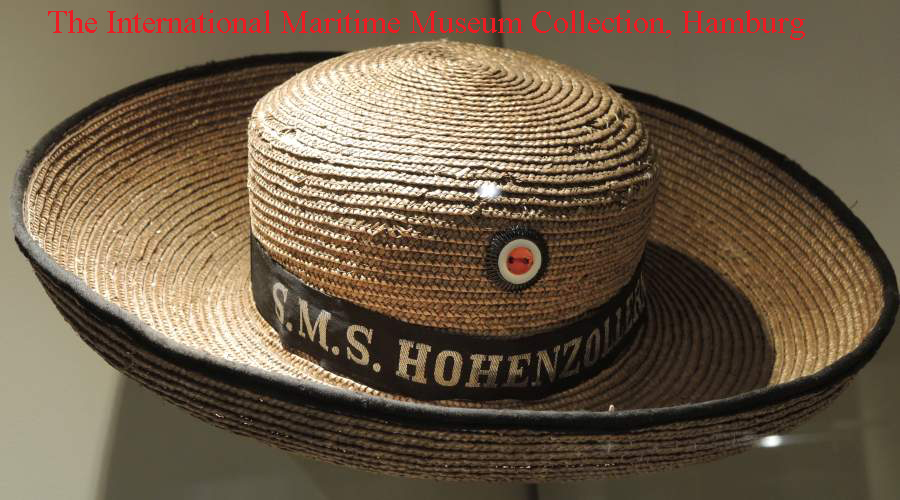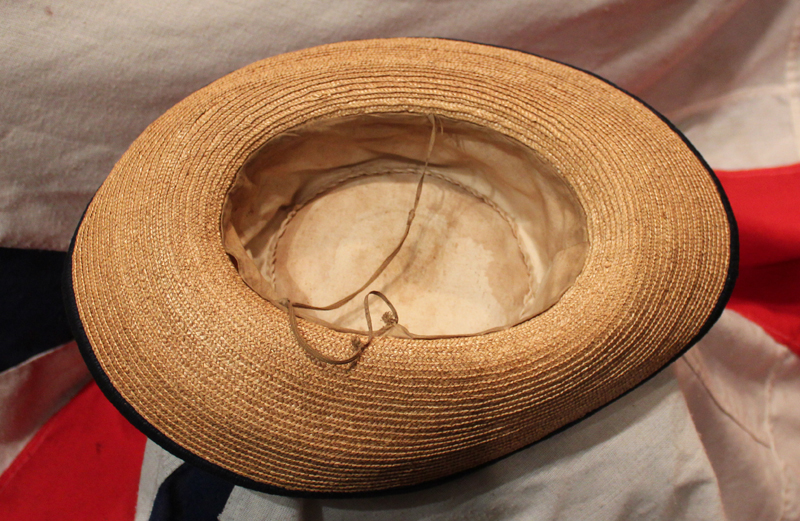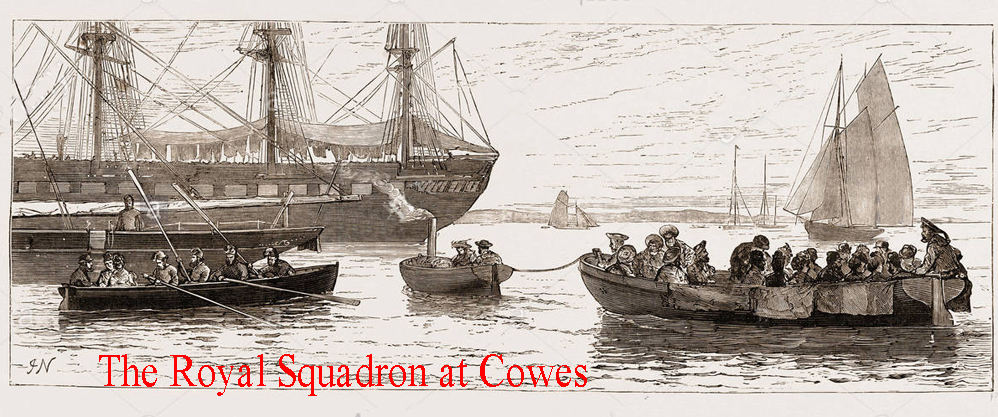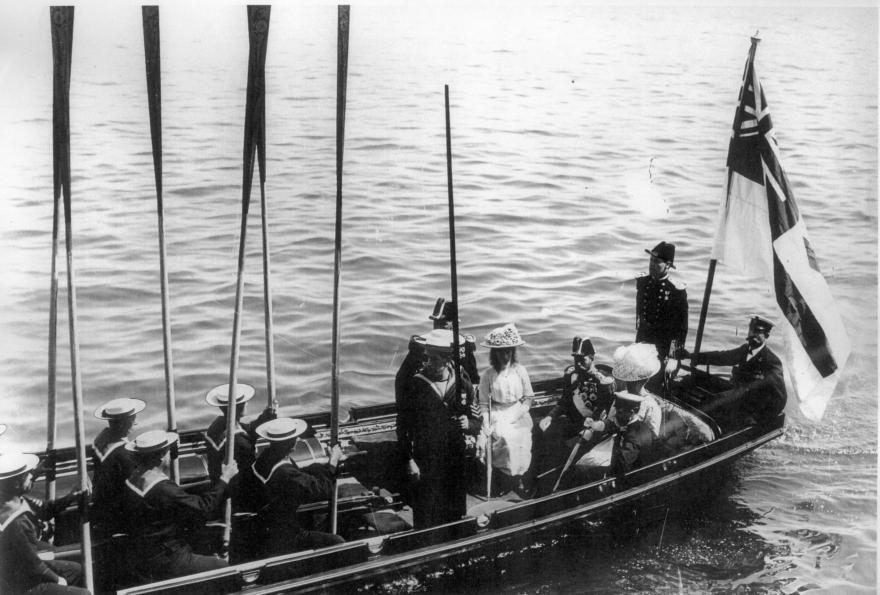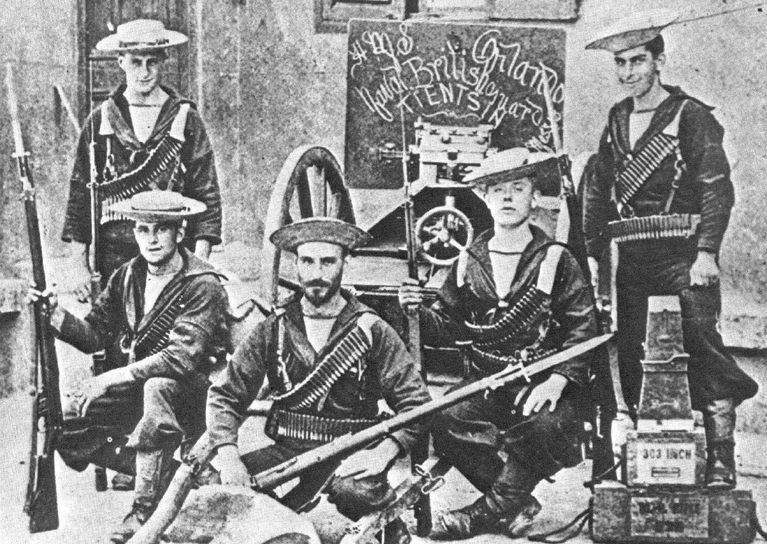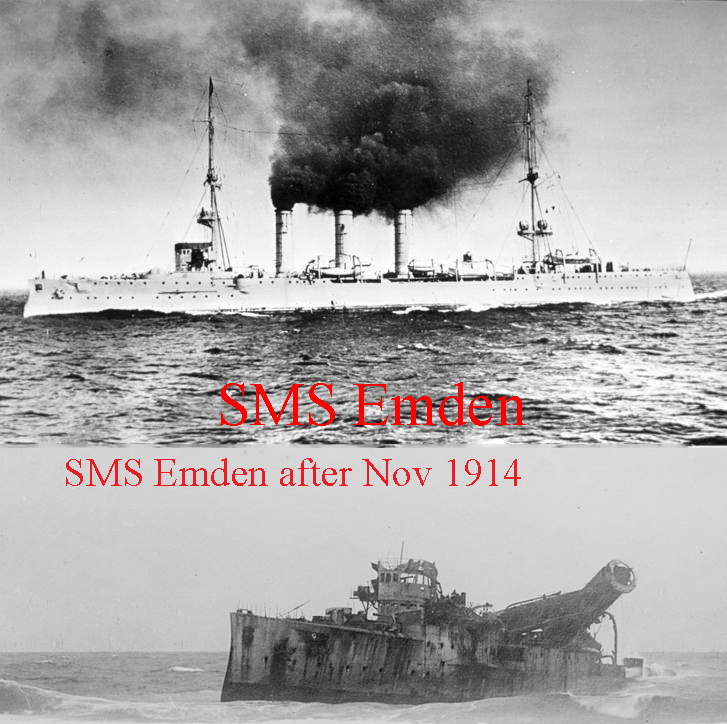A Superb and Very Rare Imperial German Naval Service Issue Straw Hat From SMS Emden One of The Most Famous Warships of WW1, It Sunk or Captured 23 Allied Ships, and 60 Allied Ships Took Part in the ‘Hunt-for-the-Emden’ Before She Was Sunk.
Bearing the wide, imperial black silk straw cap band with the embroidered badge of [SMS] Emden, with a crown over the imperial battle flag, and from family history it was used, during it's service life, on the SMS Emden's barge to transport the Kaiser to his ship before WW1, and by their sailors serving on land based duties in the concessions at Tsingtao, China from 1910. The Emden and her crew has a most significant status within German Naval history for in only three months service it sank or captured 23 ships. It fought with such valiant heroism before it was finally destroyed by the Royal Australian Navy, in November 1914, that all the surviving crew were given the singular and unique honour of having the ship's name, Emden, added as a suffix to their family surname in purpetuity. The SMS Emden was a Dresden class light cruiser launched in 1908 and posted to the East Asia squadron based at Tsingtao in 1910. She took part in the suppression of the Sokehs Rebellion on Ponape in 1910-11 and in 1913 (along with British and Japanese ships) shelled a rebel Chinese fort on the Yangtze.
When the First World War broke out the Emden, under the command of Korvettenkapitan Karl von Muller, set sail from Tsingtao to cause mayhem amongst allied shipping in the Indian Ocean and bombard enemy ports (including Madras in British India). The allies put vast efforts into catching the SMS Emden (at one point having over 60 warships involved in the search) but she eluded them, capturing and sinking thousands of tons of Entente shipping along the way. In November 1914 she was finally cornered off the Cocos Islands and sunk by the Australian light cruiser HMAS Sydney. The surviving crew of the SMS Emden were uniquely honoured for their bravery by being allowed to add the suffix '-Emden' to their surnames. To this day some of their descendants still carry this additional name. She sank eighteen merchantman, converted another to an armed merchant cruiser and captured and used three colliers. She had also raided two allied ports and sank a cruiser and a destroyer as well as causing major disruption to shipping and tying down a large number of enemy warships. Throughout the voyage she had maintained an excellent reputation for "gentlemanly" behaviour, not a single person from the merchant ships she sank was killed, prisoners were well treated and released at the earliest opportunity, enemy wounded were treated as best they could and neutral ships were treated as such.SMS Emden ("His Majesty's Ship Emden") was the second and final member of the Dresden class of light cruisers built for the Imperial German Navy (Kaiserliche Marine). Named for the town of Emden, she was laid down at the Kaiserliche Werft (Imperial Dockyard) in Danzig in 1906. Her hull was launched in May 1908, and completed in July 1909. She had one sister ship, Dresden. Like the preceding Konigsberg-class cruisers, Emden was armed with ten 10.5 cm (4.1 in) guns and two torpedo tubes.
Emden spent the majority of her career overseas in the German East Asia Squadron, based in Tsingtao, in the Kiautschou Bay concession in China. In 1913, she came under the command of Karl von Muller, who would captain the ship during World War I. At the outbreak of hostilities, Emden captured a Russian steamer and converted her into the commerce raider Cormoran. Emden rejoined the East Asia Squadron, after which she was detached for independent raiding in the Indian Ocean. The cruiser spent nearly two months operating in the region, and captured nearly two dozen ships. In late October 1914, Emden launched a surprise attack on Penang; in the resulting Battle of Penang, she sank the Russian cruiser Zhemchug and the French destroyer Mousquet.Muller then took Emden to raid the Cocos Islands, where he landed a contingent of sailors to destroy British facilities.
Emden then set of to raid the important wireless/cable station at the Cocos Islands, arriving at 0600 on November 9. A forty man landing party was put ashore unopposed and the Buresk was signalled to join Emden. Buresk did not reply but the the island started to transmit "S.O.S. Emden is here" both by wireless and cable. Only fifty miles to the north east the was the Anzac convoy which intercepted the transmission. HMAS Sydney (Captain Glossop) was detached from the convoy. Sydney was a modern light cruiser, her 6 inch main guns outgunning the 4.1 inch armed Emden. She left the convoy at 0700 and by exceeding her designed speed arrived at the Cocos after 0900.
At first Emden's lookouts thought Sydney was Buresk but when she was identified as a cruiser the landing party was recalled but were too slow and so at 0930 Emden pulled out of the lagoon without them.
Ten minutes alter Emden opened fire with her starboard guns at 10,000 yards, hitting with her third salvo, knocking out Sydney's range finder. Emden continued to score hits, knocking out a gun and starting a fire but by 1000 Sydney had found Emden's range. By 1020 Emden had lost her wireless station, a forward gun, her electrics and steering. She then received damage to her shell hoists and her firing became ragged. Sydney was a faster ship than Emden and throughout the action maintained a range best suited to her heavier guns. Emden's forward funnel fell across deck causing her to be shrouded in smoke and to reduce speed below twenty knots. For the next half an hour Emden was hit repeatedly, over 100 times during the entire action, and Captain Muller decided to beach her before she sank. At 1115 she was beached, Sydney ceasing fire five minutes later and setting off after Buresk which had just arrived. Buresk scuttled herself to prevent capture and Sydney returned to the Emden. She signalled Emden to ask for surrender but received no reply and as Emden was still flying her battle flag she opened fire again. Emden hauled down her battle flag and raised a white flag, ending the battle.
Sydney dropped off medical supplies then headed back to the main island to capture the landing party but when she arrived they had left in the commandeered schooner Ayesha. They eventually made it to Turkey in May 1915.
Emden lost 131 killed and sixty five wounded whilst Sydney suffered three killed and eight wounded. Karl von Muller was the last to leave Emden and spent the remainder of the war as a P.O.W.. Over a raiding career spanning three months and 30,000 nautical miles, Emden had destroyed two Entente warships and sank or captured sixteen British steamers and one Russian merchant ship, totaling 70,825 gross register tons. Another four British ships were captured and released. Another very rare surviving Imperial German Navy straw hat, from the Kaisers Yacht [the SMY Hohenzollern] but with it's Kaisersciffe title SMS Hohenzollern, we show it in our photograph gallery just as it is now exhibited in the The International Maritime Museum Collection, Hamburg
Code: 20572
995.00 GBP

